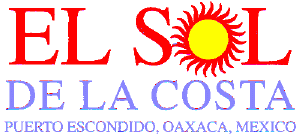

The new stop signals are located on the four-lane boulevard section of the Coast Highway. Particularly welcome is the one installed at the nightmare intersection of six roads in front of the Town Hall. The others are located at the intersection of the boulevard and Av. Carlos de Gortari, near the first entrance to Bacocho, and at the Zimat building materials store at 3rd North street.
However there is a good deal of confusion about how these lights function. So here is the official word from the state transit police. If you want to avoid a ticket, read on.
All of the new stop signals on the highway have four lights, so you can only make a left turn off the highway when the left turn arrow is lit. Furthermore, it is illegal to turn right at any of the red lights with the exception of the lights at the Crucero, the intersection with Av. Oaxaca and Av. Pérez Gasga (which runs down to the Adoquin pedestrian mall at the main beach) and the highway. These lights, along with the other set at Third North and Third West (the Ahorrará market street running down from the market (a block from the downtown gas station) have no turn arrows; they are four-way lights with each direction getting its green in sequence. Got it now?
![[beach cleaner]](images/self-propelled.jpeg) September 18 is World Beach and Seashore Clean-Up Day. And hopefully by
then, Puerto Escondido's new state-of-the-art beach sweeper will be in
operation.
September 18 is World Beach and Seashore Clean-Up Day. And hopefully by
then, Puerto Escondido's new state-of-the-art beach sweeper will be in
operation.
Unlike the beach sweepers in Cancun and Acapulco, this machine is self-propeling, not tractor pulled. In fact Puerto Escondido will be the only resort town in Mexico to possess such a device.
The sweeper, a Cherrington Beach Cleaner Sifter Harley 5000, removes all the debris from cigarette butts to empty beer bottles to depth of 15 cms and also turns over the sand so that it can be exposed to the cleansing rays of el sol (a distant relation).
The initiative to acquire the sweeper came from the association of tourist service providers of Puerto Escondido. Funds were raised through donations and raffles (including a car donated by the local federal assemblyman), but they fell well short of 1 million, 200 thousand peso price tag. The deficit was made up by the county (municipio) of San Pedro Mixtepec.
The apparatus has been delivered and factory personnel have trained municipal staff on its correct use and maintenance. But there remain some logistical problems to solve before the machine can be put into regular use, such as how and where to relocate the local fishing fleet.
There is also the problem of the long-standing territorial dispute with San Pedro's neighbor, Santa Maria Colotepec, which also claims ownership of much of Puerto Escondido. But soon this machine will have a dramatic effect on the sometimes-less-than-pristine aesthetics of our heavily used beaches and prove to be a major promotional incentive for tourism.